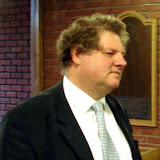The crucifixion of Jesus was routine; Matthew mentions it in a subordinate clause; it took place where probably hundreds were crucified at some time or other: The place of the skull. And in the place of skull the soldiers diced for his clothes. Strangely Matthew makes that the main verb in the sentence! This has been beautifully picked up by William Blake in a magnificent picture of the crucifixion; he has set in the foreground the gamblers rolling a dice for the mode
 st prize of Jesus clothing. In the background are the three crosses: the central one of Jesus dominating the picture. But the soldiers are so engrossed in their game that they are totally oblivious of the suffering on the crosses behind them. One man has the smile of triumph from ear to ear: he’s thrown the six that earns him Jesus’s tunic! These soldiers have come to take crucifying slaves, robbers and rebels as routine business in a day’s work: business that has the added bonus of perks like games to divide the victim’s clothes. For the winner the crucifixion in the background is a sideshow to his victory in the game.
st prize of Jesus clothing. In the background are the three crosses: the central one of Jesus dominating the picture. But the soldiers are so engrossed in their game that they are totally oblivious of the suffering on the crosses behind them. One man has the smile of triumph from ear to ear: he’s thrown the six that earns him Jesus’s tunic! These soldiers have come to take crucifying slaves, robbers and rebels as routine business in a day’s work: business that has the added bonus of perks like games to divide the victim’s clothes. For the winner the crucifixion in the background is a sideshow to his victory in the game.We are outraged: crucifixions should never be allowed to become routine: yet the place of the skull was the place where probably hundreds were crucified at some time or other: crosses and the mutilated bodies hanging on them were as much a part of the Roman world as starving Africans is part of ours. Like those Roman soldiers we too live out our petty victories against the background of appalling suffering: we in the Northern world gamble over the clothes of the poorer Southern hemisphere and celebrate our economic success oblivous of the context. Perhaps 2000 years from now people will marvel at the inhumanity of a time like ours when half the world could eat themselves to death while the other half starved: to them perhaps it will rank in obscenity as high as crucifixion does to us today.
Whatever might be let this simply be said: they led Jesus to the place of the skull, and when they had finished crucifying him they divided his clothing. Jesus joined the anonymous victims - those who were considered so low in the ranks of humanity that their bodies could be sported with, they could be nailed up on a cross naked - exposed to a hostile world - in the place of the skull. And he is with the anonymous victims still: for the place of the skull still exists in our world.
With only minor changes Matthew follows Mark’s account of the death of Jesus right up until the moment when the veil of the temple is torn in two. At that point he heightens the drama. A massive earthquake tears open the city, tombs are opened, the dead walk the streets. It is in response to this sign of elemental power let loose at them moment of Jesus’s death that the centurion and the other soldiers cried out in terror, “Surely this was God’s Son.” This is of course a most significant change, not only in the story but in the theology. In Mark the centurion seems to react to the splendour of God revealed in the broken body of Jesus. These soldiers react to a more orthodox and less unusual revelation of divine power. Matthew has already reported when Jesus entered Jerusalem the previous Sunday that the whole city was shaken. And as that happened Jesus took the disabled into the temple with him thus opening it up to those ritually unclean. Now as the city is shaken for the second time the veil of the temple is torn from top to bottom opening up the very heart of the presence of God to all comers. There was to be a third shaking when Jesus is raised: this time the very door of heaven is opened wide.
Josephus tells us that the temple veil had an embroidery upon it that represented the heavens. Just as the high priest tore his clothes when Jesus said that he would see the Son of Man seated on the right hand of God, so now as Jesus dies the temple veil is torn in testimony against priests and temple. This is getting as near as possible to the notion of God himself rending his garments in disgust at what the religious leaders have perpetrated on his Son. And it is a preparation for that much greater rending of veils when the heavens open and Jesus is revealed indeed in all his glory at the end of the gospel.


No comments:
Post a Comment